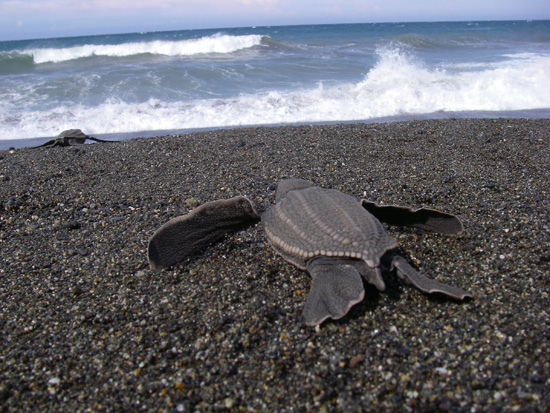October 18, 2021 - SACRAMENTO, Calif.— The California Fish and Game Commission voted last week to protect leatherback sea turtles as endangered under the state’s Endangered Species Act. The commission acted on the recommendation of the California Department of Fish and Wildlife, which is concerned by the turtles’ dramatic decline in state waters.
“California’s action will make an outsized difference for leatherback sea turtles, even in the face of global threats like the loss of nesting beaches,” said Catherine Kilduff, an attorney at the Center for Biological Diversity. “Protecting the state’s ocean to save leatherbacks benefits not only sea turtles, but whales and people too. The California Endangered Species Act will ensure that leatherbacks’ decline gets the attention it deserves during this global biodiversity crisis.”
Scientists estimate that leatherback sea turtles have declined in abundance off California by 5.6% annually over nearly 30 years. An estimated 50 Pacific leatherbacks now forage in California waters annually, as compared to 178 Pacific leatherbacks during the years 1990-2003. Whale-watching trips observed three leatherback sea turtles in August 2020 in Monterey Bay.
“Leatherbacks that forage for jellyfish off the California coast will now receive greater protection in our state from entanglement in fishing gear, giving them a better chance at survival,” said Todd Steiner, executive director of Turtle Island Restoration Network. “We are hopeful this action will put these ancient, gentle giants on a path to recovery.”
Protecting leatherbacks under the California Endangered Species Act would make them a state conservation priority. Despite the lack of regular monitoring of state fisheries, leatherback sea turtles have been found tangled in commercial rock crab gear (in 2019) and Dungeness crab gear (in 2015 and 2016).
In June 2020 the California Department of Fish and Wildlife determined that increased protections may be warranted and began the status review. The action came in response to a petition from the Center for Biological Diversity and Turtle Island Restoration Network.
A federal review of leatherback sea turtle science last year concluded that West Pacific leatherbacks, one of seven distinct populations of leatherback sea turtles worldwide, face a high extinction risk. The National Marine Fisheries Service and U.S. Fish and Wildlife Service found that all seven leatherback sea turtle populations remain endangered and denied a petition by the commercial fishing industry to relax some protections.
The California legislature has designated the Pacific leatherback sea turtle as the state marine reptile and October 15 as California’s official Pacific Leatherback Sea Turtle Conservation Day.

Leatherback Sea Turtle (Dermochelys coriacea). Credit Scott R. Benson, NOAA, Southwest Fisheries Science Center.
The Center for Biological Diversity is a national, nonprofit conservation organization with more than 1.7 million members and online activists dedicated to the protection of endangered species and wild places.
Source: Center for Biological Diversity








